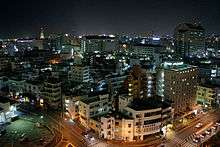Kyokuryū-kai
The Kyokuryu-kai (旭琉会, Kyokuryū-kai) is a yakuza criminal organization based on the Okinawa island of Japan,[1] with an estimated membership of 210[2]–270.[1]

Headquartered in Naha, Okinawa, the Kyokuryu-kai is one of the two designated yakuza groups in Okinawa Prefecture along with its splinter group Okinawa Kyokuryu-kai,[2] and had been Okinawa's largest organized crime group since 1983 until 1990 when the Okinawa Kyokuryu-kai broke away.[3]
History
The Kyokuryu-kai was formed in 1970 as the Okinawa-rengo Kyokuryu-kai (沖縄連合旭琉会, Okinawa-rengō Kyokuryū-kai, lit. "Okinawa-Union Kyokuryu-Group") by two gangs, the Naha Clan and the Koza Clan. These two gangs were practically not "yakuza" groups descended from the yakuza tradition (Okinawa was originally not part of Japan's territory) but were just a bunch of primitive bandits whose activities consisted of mugging United States military servicemen and smuggling valuables from nearby wealthier places such as Taiwan and Hong Kong , and they had originally opposed each other until that merger. They formed the union in the year of 1970, shortly before the return of Okinawa to Japan, with the alleged purpose of preventing yakuza's invasion from the mainland.[3]

From 1973 to 1981, the Kyokuryu-kai was in fierce conflict with the Yamaguchi-gumi, the largest known yakuza syndicate attempting to expand its influence into Okinawa at that time. Later dubbed the "4th Okinawa War" (第4次沖縄抗争) and described as a "war of slaughter", this conflict often involved carbines, magnum bullets and hand grenades among other weapons, and was considered one of the most brutal yakuza conflicts in the 20th century.[4] Unlike the Dojin-kai, which had also been in conflict with the Yamaguchi-gumi in the late 20th century, the Kyokuryu-kai had never committed unconventional gruesome acts such as mass destruction and mass murder, but the victims included an innocent katagi, or ordinary civilian; a policeman who was shot with a carbine by a Kyokuryu member.[5]
The first president resigned in 1976, and the second president was shot to death in 1982 by an affiliate organization. Yoshihiro Onaga became the third president in 1983,[6] and membership reached 1,000.[3] In 1990 an internal war broke out, and Kiyoshi Tominaga founded a splinter organization, the Okinawa Kyokuryu-kai.[6] In June 1992 the Kyokuryu-kai, along with the Okinawa Kyokuryu-kai, was registered as a designated yakuza group under the Organized Crime Countermeasures Law.[7]
The Kyokuryu-kai seems to have adopted the yakuza tradition extensively; the National Police Agency's 1993 Police White Paper introduced a total of two notable cases of yubitsume, or finger cutting, and in these two cases, one was of a Kyokuryu-kai member, the other was of an Okinawa Kyokuryu-kai member.[8]
Condition
The Kyokuryu-kai had been in conflict with the Okinawa Kyokuryu-kai for years, but it has been reported that they have been pondering a reconciliation since 1998.[9]
Activities
The Kyokuryu-kai's official policy forbids its members from engaging in drug trafficking.[10]
Presidents
- 1st (1970-197*): Yoshitada Nakamoto
- 2nd (1976–1982): Shinzan Tawada
- 3rd (1983-2010): Yoshihiro Onaga
- 4th (2010–present): Shoichi Hanaki
References
- "Police of Japan 2011, Criminal Investigation : 2. Fight Against Organized Crime" Archived 2011-08-10 at the Wayback Machine, December 2009, National Police Agency
- "Boryokudan Situation in 2010", p.27, April 2011, National Police Agency (in Japanese)
- "Outline of Boryokudan in Okinawa Prefecture" Archived 2012-02-14 at the Wayback Machine, October 2007, Okinawa Prefectural Police (in Japanese)
- "Conflict History of the Yamaguchi-gumi : Yamaguchi-gumi v.s. Okinawa Yakuza", Yasuaki Doi & Tetsuro Futatsugi, 15 February 2010, ISBN 978-4-8124-6990-3 (in Japanese)
- "1978 Police White Paper Chapter 2 : For Boryokudan Elimination", 1978, National Police Agency (in Japanese)
- "A phenomenon of boryokudan unification, The third Kyokuryu-kai president changes" Archived 2010-07-05 at the Wayback Machine, 3 July 2010, Ryukyu Shimpo (in Japanese)
- "5 years from the enactment of the Organized Crime Countermeasures Law" Archived 2012-03-19 at the Wayback Machine, 1 March 1997, Ryukyu Shimpo (in Japanese)
- "1993 Police White Paper Chapter 1 : The Actual Condition of the Boryokudan", 1993, National Police Agency (in Japanese)
- "A phenomenon of boryokudan unification, The third Kyokuryu-kai president changes (Ryukyu Shimpo)", 3 July 2010, Livedoor (in Japanese)
- "Drug cases, The prefectural police : '40% are related to the boryokudan'" Archived 2010-01-17 at the Wayback Machine, 29 November 2008, Ryukyu Shimpo (in Japanese)